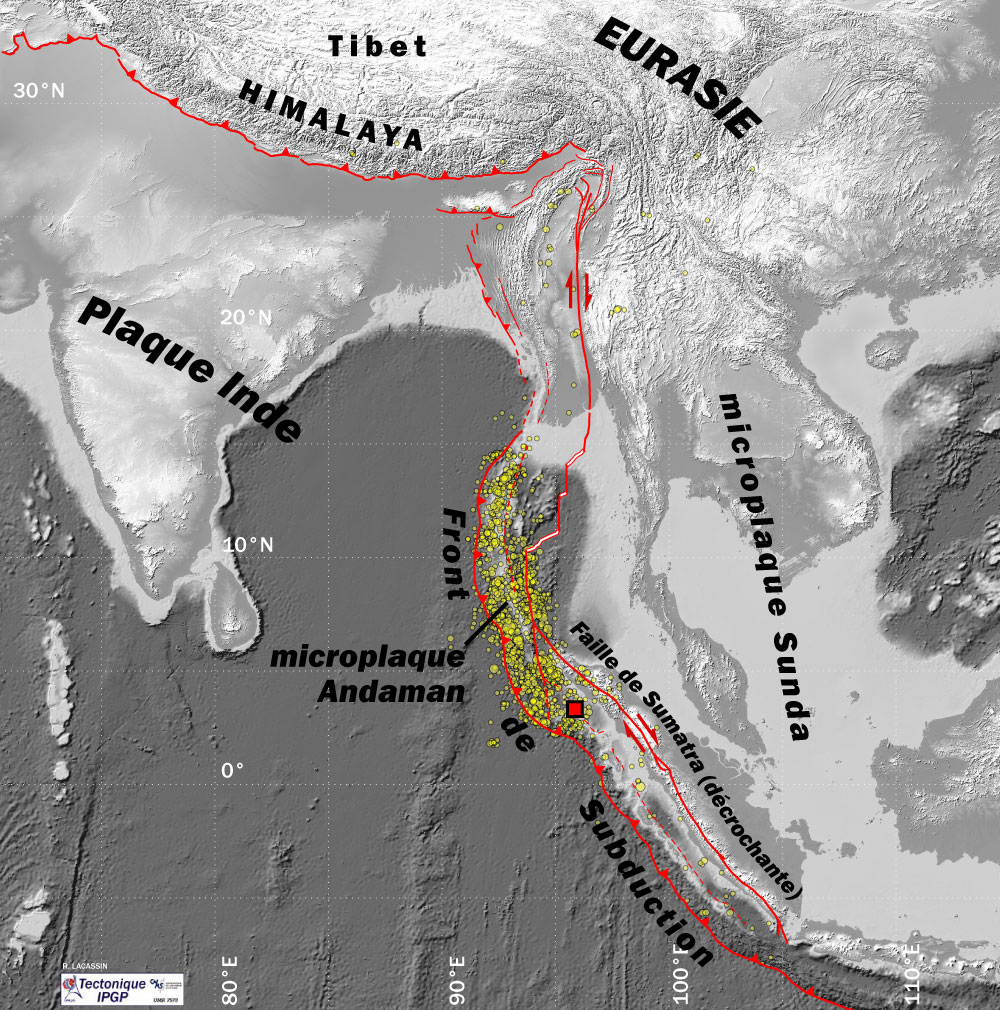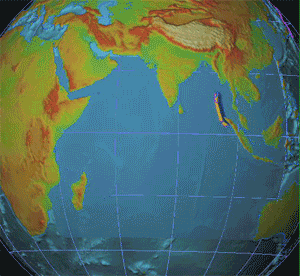|
Aftershock
In seismology, an aftershock is a smaller earthquake that follows a larger earthquake, in Epicenter, the same area of the Mainshock, main shock, caused as the displaced Crust (geology), crust adjusts to the effects of the main shock. Large earthquakes can have hundreds to thousands of instrumentally detectable aftershocks, which steadily decrease in magnitude and frequency according to #Aftershock size and frequency with time, a consistent pattern. In some earthquakes the main rupture happens in two or more steps, resulting in multiple main shocks. These are known as doublet earthquakes, and in general can be distinguished from aftershocks in having similar magnitudes and nearly identical seismic waveforms. Distribution of aftershocks Most aftershocks are located over the full area of fault rupture and either occur along the fault plane itself or along other faults within the volume affected by the strain associated with the main shock. Typically, aftershocks are found up to a d ... [...More Info...] [...Related Items...] OR: [Wikipedia] [Google] [Baidu] |
Earthquake
An earthquakealso called a quake, tremor, or tembloris the shaking of the Earth's surface resulting from a sudden release of energy in the lithosphere that creates seismic waves. Earthquakes can range in intensity, from those so weak they cannot be felt, to those violent enough to propel objects and people into the air, damage critical infrastructure, and wreak destruction across entire cities. The seismic activity of an area is the frequency, type, and size of earthquakes experienced over a particular time. The seismicity at a particular location in the Earth is the average rate of seismic energy release per unit volume. In its most general sense, the word ''earthquake'' is used to describe any seismic event that generates seismic waves. Earthquakes can occur naturally or be induced by human activities, such as mining, fracking, and nuclear weapons testing. The initial point of rupture is called the hypocenter or focus, while the ground level directly above it is the ... [...More Info...] [...Related Items...] OR: [Wikipedia] [Google] [Baidu] |
Mainshock
In seismology, the mainshock is the largest earthquake in a sequence, sometimes preceded by one or more foreshocks, and almost always followed by many aftershocks. Foreshock A foreshock is an earthquake that occurs before a larger seismic event (the mainshock) and is related to it in both time and space. The designation of an earthquake as ''foreshock'', ''mainshock'' or aftershock is only possible after the full sequence of events has happened. Aftershock In seismology, an aftershock is a smaller earthquake that follows a larger earthquake, in the same area of the main shock, caused as the displaced crust adjusts to the effects of the main shock. Large earthquakes can have hundreds to thousands of instrumentally detectable aftershocks, which steadily decrease in magnitude and frequency according to known laws. In some earthquakes the main rupture happens in two or more steps, resulting in multiple main shocks. These are known as doublet earthquakes Doublet is a word de ... [...More Info...] [...Related Items...] OR: [Wikipedia] [Google] [Baidu] |
2008 Sichuan Earthquake
An earthquake occurred in the province of Sichuan, China at 14:28:01 China Standard Time on May 12, 2008. Measuring at 8.0 (7.9–8.3 ), the earthquake's epicenter was located boxing the compass, west-northwest of Chengdu, the provincial capital, with a Hypocenter, focal depth of . The earthquake ruptured the fault for over , with surface displacements of several meters. The earthquake was also felt as far away as Beijing and Shanghai— away, respectively—where office buildings swayed with the tremor, as well as Bangkok, Thailand and Hanoi, Vietnam. Strong aftershocks, some exceeding 6 , continued to hit the area up to several months after the main shock, causing further casualties and damage. The earthquake also caused the largest number of geohazards ever recorded, including about 200,000 landslides and more than 800 Landslide dam, quake lakes distributed over an area of . Over 69,000 people lost their lives in the quake, including 68,636 in Sichuan province. 374,176 ... [...More Info...] [...Related Items...] OR: [Wikipedia] [Google] [Baidu] |
2004 Indian Ocean Earthquake
On 26 December 2004, at 07:58:53 local time (UTC+07:00, UTC+7), a major earthquake with a magnitude of 9.2–9.3 struck with an epicenter, epicentre off the west coast of Aceh in northern Sumatra, Indonesia. The Submarine earthquake, undersea megathrust earthquake, known in the scientific community as the Sumatra–Andaman earthquake, was caused by a rupture along the fault between the Burma plate and the Indian plate, and reached a Modified Mercalli intensity scale, Mercalli intensity of IX in some areas. A massive tsunami with waves up to high, known as the Boxing Day Tsunami after the Boxing Day holiday, or as the Asian Tsunami, devastated communities along the surrounding coasts of the Indian Ocean, killing an estimated 227,898 people in 14 countries, violently in Aceh (Indonesia), and severely in Sri Lanka, Tamil Nadu (India), and Khao Lak (Thailand). The direct result was major disruption to living conditions and commerce in coastal provinces of surrounding countries. I ... [...More Info...] [...Related Items...] OR: [Wikipedia] [Google] [Baidu] |
Doublet Earthquake
__NOTOC__ In seismology, doublet earthquakes – and more generally, multiplet earthquakes – were originally identified as multiple earthquakes with nearly identical waveforms originating from the same location. They are now characterized as distinct earthquake sequences having two (or more) main shocks of similar magnitude, sometimes occurring within tens of seconds, but sometimes separated by years. The similarity of magnitude – often within 0.4 magnitude – distinguishes multiplet events from aftershocks, which start at about 1.2 magnitude less than the parent shock ( Båth's law) and decrease in magnitude and frequency according to known laws. Doublet/multiplet events also have nearly identical seismic waveforms, as they come from the same rupture zone and stress field, whereas aftershocks, being peripheral to the main rupture, typically reflect more diverse circumstances of origin. Multiplet events overlap in their focal fields (rupture zones), which can be up 100 kilome ... [...More Info...] [...Related Items...] OR: [Wikipedia] [Google] [Baidu] |
Seismology
Seismology (; from Ancient Greek σεισμός (''seismós'') meaning "earthquake" and -λογία (''-logía'') meaning "study of") is the scientific study of earthquakes (or generally, quakes) and the generation and propagation of elastic waves through planetary bodies. It also includes studies of the environmental effects of earthquakes such as tsunamis; other seismic sources such as volcanoes, plate tectonics, glaciers, rivers, oceanic microseisms, and the atmosphere; and artificial processes such as explosions. Paleoseismology is a related field that uses geology to infer information regarding past earthquakes. A recording of Earth's motion as a function of time, created by a seismograph is called a seismogram. A seismologist is a scientist who works in basic or applied seismology. History Scholarly interest in earthquakes can be traced back to antiquity. Early speculations on the natural causes of earthquakes were included in the writings of Thales of Miletu ... [...More Info...] [...Related Items...] OR: [Wikipedia] [Google] [Baidu] |
Earthquake Prediction
Earthquake prediction is a branch of the science of geophysics, primarily seismology, concerned with the specification of the time, location, and magnitude of future earthquakes within stated limits, and particularly "the determination of parameters for the ''next'' strong earthquake to occur in a region". Earthquake prediction is sometimes distinguished from '' earthquake forecasting'', which can be defined as the probabilistic assessment of ''general'' earthquake hazard, including the frequency and magnitude of damaging earthquakes in a given area over years or decades. Prediction can be further distinguished from earthquake warning systems, which, upon detection of an earthquake, provide a real-time warning of seconds to neighboring regions that might be affected. In the 1970s, scientists were optimistic that a practical method for predicting earthquakes would soon be found, but by the 1990s continuing failure led many to question whether it was even possible. Demonstrabl ... [...More Info...] [...Related Items...] OR: [Wikipedia] [Google] [Baidu] |
Seismology
Seismology (; from Ancient Greek σεισμός (''seismós'') meaning "earthquake" and -λογία (''-logía'') meaning "study of") is the scientific study of earthquakes (or generally, quakes) and the generation and propagation of elastic waves through planetary bodies. It also includes studies of the environmental effects of earthquakes such as tsunamis; other seismic sources such as volcanoes, plate tectonics, glaciers, rivers, oceanic microseisms, and the atmosphere; and artificial processes such as explosions. Paleoseismology is a related field that uses geology to infer information regarding past earthquakes. A recording of Earth's motion as a function of time, created by a seismograph is called a seismogram. A seismologist is a scientist who works in basic or applied seismology. History Scholarly interest in earthquakes can be traced back to antiquity. Early speculations on the natural causes of earthquakes were included in the writings of Thales of Miletu ... [...More Info...] [...Related Items...] OR: [Wikipedia] [Google] [Baidu] |
Science Daily
''ScienceDaily'' is an American website launched in 1995 that aggregates press releases and publishes lightly edited press releases (a practice called churnalism) about science, similar to Phys.org and EurekAlert!. History The site was founded by married couple Dan and Michele Hogan in 1995; Dan Hogan formerly worked in the public affairs department of Jackson Laboratory writing press releases. The site makes money from selling advertisements. the site said that it had grown "from a two-person operation to a full-fledged news business with worldwide contributors". At the time, it was run out of the Hogans' home, had no reporters, and only reprinted press releases. In 2012, Quantcast ranked it at 614 with 2.6 million U.S. visitors. Sections As of August 2023, ''ScienceDaily'' mainly has five sections, Health, Tech, Enviro, Society, and Quirky, the last of which includes the top news. References External links * Alexa - ScienceDaily��{{Webarchive, url=https://web.a ... [...More Info...] [...Related Items...] OR: [Wikipedia] [Google] [Baidu] |



